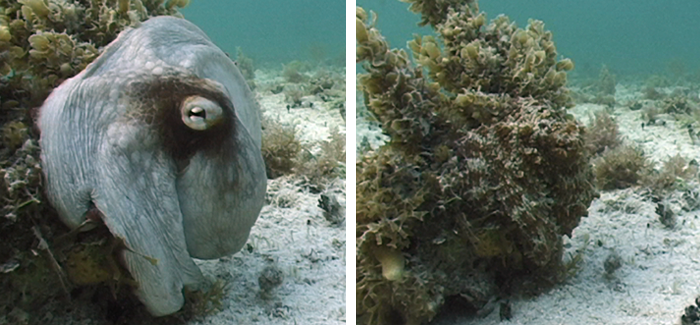
Stills from a video by marine biologist Roger Hanlon show an Octopus vulgaris changing its camouflage. (Photos courtesy Roger Hanlon)
Neurobiologist Clifton Ragsdale’s work advances the knowledge of understudied cephalopods.
Cephalopods are novel—even bizarre—creatures. A group that includes octopuses, squid, cuttlefish, and nautiluses, they can change color and texture in an instant for camouflage or communication. Their eyes are vertebrate-like, with an iris and a lens. They can regenerate lost tentacles. Some measure only a few centimeters, while others, like the giant squid, can grow to almost 50 feet long. Instead of swimming like fish, they use jet propulsion to get around. And they have the most complex nervous systems and the largest brains among invertebrates.
The broad motivation for studying cephalopods, says UChicago neurobiologist Clifton Ragsdale, “is that these are the largest animals that we know of that are the most distant from us.” Ragsdale is particularly focused on the ways these creatures evolved, and how those ways are similar and dissimilar to invertebrate evolution. For Ragsdale, one driving question is: how does nature make a big brain? Like humans, octopuses have large brains, but unlike humans and other vertebrates, their neurons are decentralized—not concentrated in the head but spread out among the tentacles and body.
As a systems neuroscientist, Ragsdale says, “I want to know how these brains are designed differently from the vertebrate plan. The idea being: there may be general constraints on how you can organize big sensorimotor cognitive brains”—including octopus brains—“but this will tell us how far they can diverge.” Understanding how they diverge can provide clues to the ways different neurological systems evolve, and to how and when species’ evolution diverged.
Ragsdale’s interest in cephalopods dates back to a College class he taught in the 1990s, which introduced the vertebrate central nervous system by comparing it with those of invertebrates in general and cephalopods in particular. The idea of studying cephalopods lay dormant until about six years ago, when he learned that there had been very little work done on them in terms of modern systems neuroscience or molecular cellular biology.
In fact, no cephalopod genome had been mapped, making the study of comparative evolution between species impossible. Even today, no complete genome has been mapped for any single cephalopod—in part because relatively few researchers had coordinated their work. Nor had there been a focus on a particular species, a real problem when it comes to the painstaking work of gene sequencing.
To bolster collaboration, Ragsdale enlisted Roger Hanlon, a cephalopod researcher at the Marine Biological Laboratory at Woods Hole, Massachusetts. In 2012 Ragsdale helped organize a National Science Foundation–funded conference in which Hanlon was also involved. The event brought together 29 cephalopod researchers and yielded a white paper that targeted ten species for research.
Ragsdale and his lab, including PhD candidate Carrie Albertin, SM’12, have chosen to study Octopus bimaculoides, which is plentiful off the coasts of California and Mexico. Also called the two-spotted octopus, it is smallish, with a mantle about seven inches across and tentacles two feet long. The species is ideal for experimental purposes—they’re hardy and they breed almost all year, which makes it easier to maintain a population in the tanks in Ragsdale’s Abbott Hall laboratory.
Besides the octopus’s large-for-an-invertebrate brain, each of its eight tentacles has a nerve cord with as many neurons as the brains of many small mammals. The octopus’s eggs are comparatively large (about a centimeter) and the eggshell is transparent. Looking at an octopus egg through a microscope, you can see the embryo’s eyes, its three hearts, and chromatophores—the mechanisms that help the octopus make those dramatic color changes.
In one lab tank a young octopus is comfortably huddled in the hollow side of a yellow Lego block, its favorite resting place, Albertin says. The octopus seems to take notice when she approaches, and she coaxes it to jet itself out of the block toward a decorative rock on the bottom of the tank.
Albertin studies embryological development, identifying where genes are expressed in the octopus. That requires tissue sampling of embryos at different developmental stages, a painstaking process. Using fluorescent labels to mark certain proteins, she identified a gene known to be a critical part of human eye development that also expresses itself in octopus eye development.
Each such identification is a tiny piece in an enormous puzzle. Working to assemble a complete genome, Ragsdale’s lab depends on UChicago’s Genomics Facility for computational horsepower and on the University’s Center for Research Informatics for memory storage hardware and support.
Another promising development: in July the Marine Biological Laboratory began a formal affiliation with UChicago. Hanlon is excited by the collaborative possibilities, particularly with Ragsdale. “We have been missing the hard-core card-carrying neurobiologists,” says Hanlon, adding that he appreciates Ragsdale “switching gears into this unorthodox animal group.”
